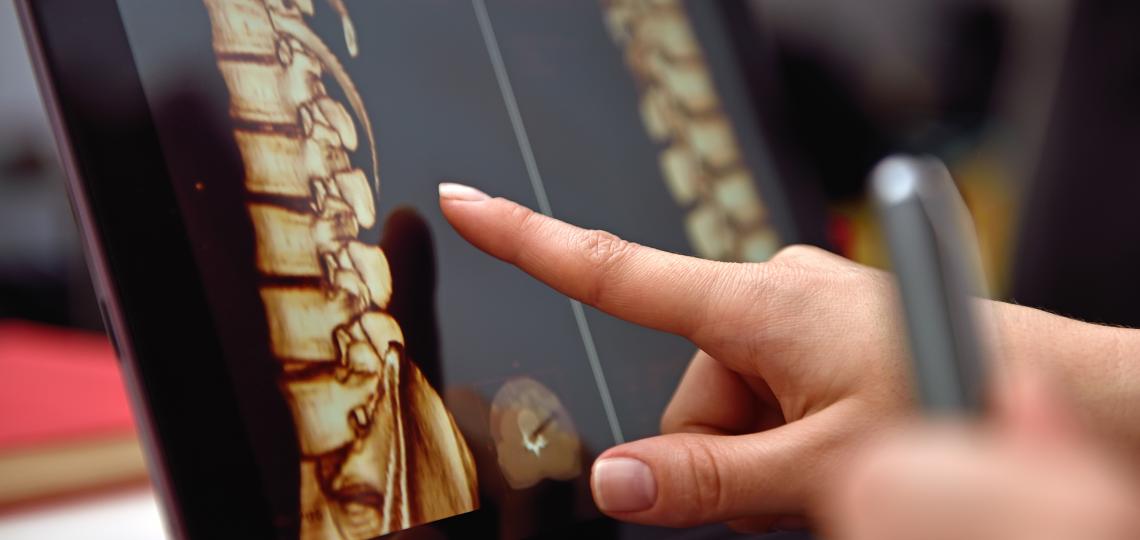
At the Baylor Medicine Spine Center, we treat varied and complex clinical problems associated with the spine. We treat all diseases of the cervical, thoracic and lumbar spine including:
General Spine Conditions
 Credit
Credit
There are conditions that are not specific to any region of the spine or can affect several regions of the spine. They include:
- Adult Spinal Deformities
- Ankylosing Spondylitis (AS)
- Back and Neck Pain
- Scoliosis
- Spinal Cord Injuries and Compression
- Spinal Fractures and Trauma
- Spinal Infections
- Spinal Pain, including pain after spinal surgery (Post-laminectomy Syndrome)
- Spinal Stenosis
- Spinal Tumors
- Spondylitis / Spondyloarthritis / Spondyloarthropathy
Cervical Spine (Neck Region)
The neck region of the spinal column is called the cervical spine. It has seven bones (C1-C7 vertebrae) which are separated from each other by discs. These discs are composed of a capsule of connective tissue surrounding a soft, jellylike center. These discs absorb shock and provide flexibility within the spine.
- Basilar Invagination
- Cervical Arthritis
- Cervical Spine Fractures (Broken Neck)
- Cervical Myelopathy (Cervical Spinal Cord Compression)
- Cervical Radiculopathy
- Facet Arthropathy
- Herniated Disc (Ruptured Disc or Slipped Disc)
- Spinal Stenosis
- Spondylolysis
Thoracic Spine (Upper and Middle Back)
The upper and middle back is called the thoracic spine. It has 12 vertebrae, which attach to your rib cage. They make up the longest part of your back. Discs separate the vertebrae and absorb shock as you move. Muscles and ligaments hold the spine together.
- Kyphosis
- Scoliosis
- Spinal Fracture (Broken Back)
- Thoracic Disc Herniation
Lumbar Spine (Lower Back)
The lower back is called the lumbar spine. It has five vertebrae, in the lower part of the spine between the ribs and pelvis. They make up the longest part of your back. Discs separate the vertebrae and absorb shock as you move. Muscles and ligaments hold the spine together.
- Chronic Lower Back Pain
- Degenerative Disc Disease
- Facet Arthropathy
- Flat Back Syndrome
- Herniated Disc (Ruptured Disc or Slipped Disc)
- Lumbar Claudation / Neurogenic Claudation
- Lumbar Scoliosis and Spinal Deformities
- Sciatica
- Spinal Fracture (Broken Back)
- Spinal Stenosis
- Spondylolisthesis Spondylolysis (Pars Defects)
Sacrum (Pelvis)
The sacrum is the lowest portion of the spine. It is a single bone that connects the spine to the pelvis.
- Coccydnia (Tailbone Pain)
- Fractures of the Sacrum and Coccyx (Broken Pelvis and Tailbone)
- Sacral Nerve Compression
- Sacroilitis
- SI (Sacroiliac) Joint Dysfunction
- Spinal Tumors
Services and Treatments
Rest assured that when you seek care at Baylor Medicine’s Spine Center, you’ll have access to the most advanced, evidence-based surgical and non-surgical treatments available.
Meet the Spine Team
From chronic lower back pain to spinal fractures our team of physicians specialize in the care and treatment of a variety of spinal conditions.








